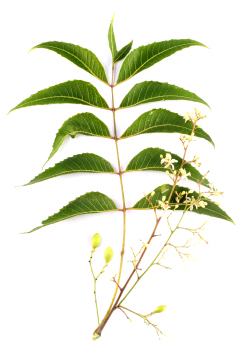 Organic Pesticide Profile: Neem Oil
Organic Pesticide Profile: Neem Oil
(click here to download this profile from my personal Gardening Guide)
This is one of my favorite organic pest controls. I learned about it several years ago and I’ve used it ever since, with great successes. I hope you find it useful too!
Neem oil is extracted from the seeds of the Neem Tree (Azadirachta indica). For thousands of years it has been used in India’s Ayurvedic medicine tradition for everything from toothpaste to a contraceptive. It is also used as a flea and tick repellent for dogs and other animals, and in the 1980’s Neem oil was registered with the US EPA as a pesticide. It’s very effective as both a pest control treatment and preventative, and when applied correctly, it will not harm beneficial insects. Keep in mind, that like many natural substances, Neem oil can be toxic so you’ll want to understand proper use of the product before applying it on your plants.
How it Works
Neem oil is a contact and systemic, all-natural pesticide, found to be useful in treating over 200 species of pests (especially their eggs) and some common fungal diseases. It is especially good for treating and repelling, leaf-eating insects. When applied as a preventative, it is drawn up by the plant’s roots and deposited throughout the plant’s tissue. The smell alone can prevent many insects from snacking on the plant. When sprayed on the foliage, it forms a film on the plant’s leaves, essentially suffocating pests and their larvae, which are then prevented from transitioning to the pupal stage and they die soon afterwards.
Once dry, insects are safe to land on the neem oil sprayed foliage; however, once they begin to feed on the leaves and ingest the Neem oil, a neurological change will occur and the insect will “forget” to eat and reproduce, and will die within a few days. Keep in mind that Neem oil will not kill entire colonies on contact, it will take a few days to stop the life cycle of the pest.
Many beneficial insects are not leaf-eating, so Neem oil is safe for many beneficial insects like butterflies, honeybees and ladybird beetles (also known as ladybugs), once it is dry.
How to Use
As a Preventative:
Water plants with diluted* Neem oil solution. Oil can remain in the plant’s tissues for up to 2 months.
As a Treatment:
Generously spray diluted* Neem oil on all plant surfaces, including underside of leaves and flowers. Wait a 3-4 days to see if the pests have been eliminated, if not, treat again.
Neem is an oil and can act as a sunlight reflectant on leaves, causing burning. To avoid this, apply in early morning or late afternoon when the plant will not receive direct sunlight for several hours and when temperatures are under 90°. Do not apply to wet plants or in damp conditions, this will prevent the oil from drying quickly and in it’s wet state, it can be harmful to beneficial insects that land on it.
*See “Additional Information” below for mixing instructions.
Organisms Controlled
Pests – gypsy moths, whiteflies, mealybugs, Japanese beetles, leaf miners, Colorado potato beetle, aphids, flea beetles, thrips, cutworms, armyworms, billbugs, borers/clearwing moths, cankerworms, corn ear worms, lace bugs, mites, leafhoppers, Mexican bean beetle, bagworm, sawfly, scale
Fungus – Powdery Mildew, Downy Mildew, Brown Patch (Rhizocttonia solani)
Storage and Disposal
Store undiluted Neem oil in a sealed container, between 65°-95° for up to 2 years.
Additional Information
Prior to application, Neem oil should be diluted with water. You will be combining oil and water, so you’ll need an emulsifier like liquid dish soap. Add the following ingredients to a spray bottle or other sealable container and shake well prior to use. You can exponentially reduce the amounts of each ingredient to create smaller batches.
- 1 quart (4 cups) water
- 1 1/2 tsp. Neem oil
- 1/3 tsp. organic/natural liquid dish soap (or other natural emulsifier)
Cautions
When purchasing Neem oil, be sure that you are buying 100% Neem oil. There are many manufacturers that have begun to mix additional ingredients and chemicals with the Neem oil, so check your labels!
Use with caution on delicate plants, such as ferns and the Aurelia family. Dilute with additional water and test on one leaf, prior to treating the entire plant.
Neem oil is safe for use on vegetables and fruits, but the oil should be allowed to dry before the vegetables or fruits are handled. Rinse vegetables and fruit in warm soapy water prior to consuming.
Additional safety information and a list of resources can be found on the complete profile here.
Additional Names: Cold Pressed Neem Oil, Horticultural Oil

Thanks for the tip, Mom and I used it on tomato plants … it took care of the leaf miner and didn’t poison us! (or did it)
haha. Or did it.
In my environmental textbook, i just learned about pesticides. And NONE of them were good for the environment. But this is great for gardening
Yeah, some of those chemicals can be really scary and they’re on our food. Eek! Glad to hear they have you studying that kind of stuff!
Best of all it lets ladybugs survive! (I havent seen one in like two yrs.)
The answers here is truly effective informative. I have uncovered many suggestions.